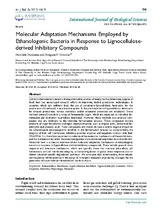| dc.contributor.author | Ndimba, Bongani K. | |
| dc.contributor.author | Ibraheem, Omodele | |
| dc.date.accessioned | 2017-02-17T09:19:40Z | |
| dc.date.available | 2017-02-17T09:19:40Z | |
| dc.date.issued | 2013 | |
| dc.identifier.citation | Ndimba, B. K. et al. (2013). Molecular adaptation mechanisms employed by ethanologenic bacteria in response to lignocellulosederived inhibitory compounds. International Journal of Biological Sciences, 9(6): 598-612 | en_US |
| dc.identifier.issn | 1449-2288 | |
| dc.identifier.uri | http://hdl.handle.net/10566/2541 | |
| dc.identifier.uri | http://dx.doi.org/10.7150/ijbs.6091 | |
| dc.description.abstract | Current international interest in finding alternative sources of energy to the diminishing supplies of
fossil fuels has encouraged research efforts in improving biofuel production technologies. In
countries which lack sufficient food, the use of sustainable lignocellulosic feedstocks, for the
production of bioethanol, is an attractive option. In the pre-treatment of lignocellulosic feedstocks
for ethanol production, various chemicals and/or enzymatic processes are employed. These
methods generally result in a range of fermentable sugars, which are subjected to microbial fermentation
and distillation to produce bioethanol. However, these methods also produce compounds
that are inhibitory to the microbial fermentation process. These compounds include
products of sugar dehydration and lignin depolymerisation, such as organic acids, derivatised furaldehydes
and phenolic acids. These compounds are known to have a severe negative impact on
the ethanologenic microorganisms involved in the fermentation process by compromising the
integrity of their cell membranes, inhibiting essential enzymes and negatively interact with their
DNA/RNA. It is therefore important to understand the molecular mechanisms of these inhibitions,
and the mechanisms by which these microorganisms show increased adaptation to such inhibitors.
Presented here is a concise overview of the molecular adaptation mechanisms of ethanologenic
bacteria in response to lignocellulose-derived inhibitory compounds. These include general stress
response and tolerance mechanisms, which are typically those that maintain intracellular pH
homeostasis and cell membrane integrity, activation/regulation of global stress responses and inhibitor
substrate-specific degradation pathways. We anticipate that understanding these adaptation
responses will be essential in the design of ‘intelligent’ metabolic engineering strategies for the
generation of hyper-tolerant fermentation bacteria strains. | en_US |
| dc.language.iso | en | en_US |
| dc.publisher | Ivyspring | en_US |
| dc.rights | This is an open access article distributed under the terms of the Creative Commons Attribution (CC BY-NC) License. See http://ivyspring.com/terms for full terms and conditions. | |
| dc.subject | Fermentation | en_US |
| dc.subject | Bioethanol | en_US |
| dc.subject | Lignocellulosic Inhibitors | en_US |
| dc.subject | Lignocellulolytic materials | en_US |
| dc.subject | Stress Response | en_US |
| dc.subject | Microbial Physiology | en_US |
| dc.subject | Phenolics | en_US |
| dc.title | Molecular adaptation mechanisms employed by ethanologenic bacteria in response to lignocellulose-derived inhibitory compounds | en_US |
| dc.type | Article | en_US |
| dc.privacy.showsubmitter | FALSE | |
| dc.status.ispeerreviewed | TRUE | |
| dc.description.accreditation | ISI | |

